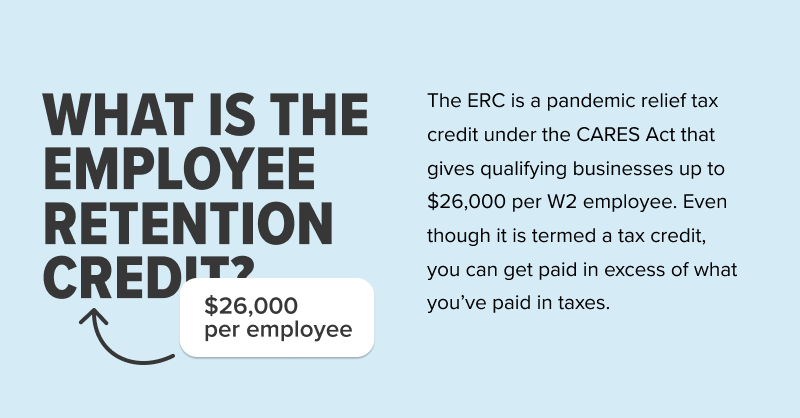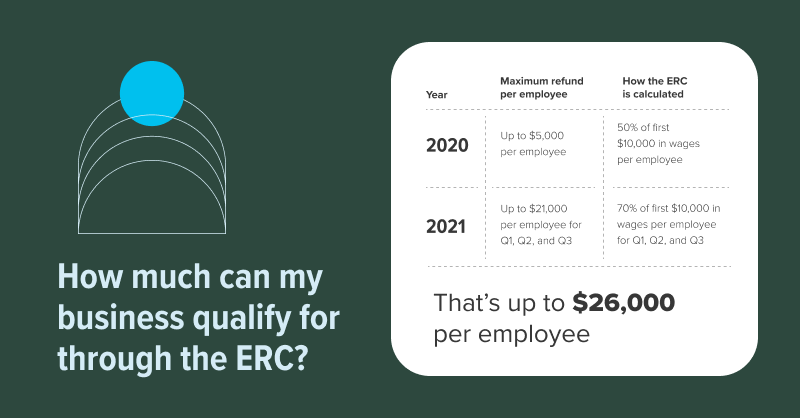- Example active heading
- Example heading
Have you heard of the Employee Retention Credit (ERC)? For business owners who endured the COVID-19 pandemic and the economic roller-coaster it brought, the ERC was meant to provide financial relief and keep their workforce employed. Now, even though the economic impacts of the pandemic have subsided, business owners like you can still take advantage of this tax credit. To find out if you qualify and how the Employee Retention Credit works, read our answers to the Employee Retention Credit FAQs below.
General overview questions
What is the Employee Retention Credit (ERC)?

The ERC is a tax credit. This means, when applied, the ERC will reduce the total amount of taxes a business owes to the Internal Revenue Service (IRS). The ERC was part of the Coronavirus Aid, Relief, and Economic Security Act (CARES Act) which was passed in March 2020 by the U.S. Congress. It was intended to lessen the pandemic's economic impact on businesses and encourage them to retain employees as much as possible.
The ERC is a fully refundable tax credit. This means, that if your business’ ERC is greater than your federal employment taxes, it could create a negative federal tax liability for a business and result in a tax refund. At the very least, it could lower the amount of taxes your business pays—at most, you could receive a refund check.
Am I eligible for the Employee Retention Credit?
To be eligible to receive the Employee Retention Credit, you must meet the following criteria:
- Your business is a private sector or tax-exempt organization that carried out business in 2020 and/or 2021.
- Your business paid qualified wages to employees in 2020 and/or 2021.
- Your business experienced hardship in one of the following areas:
- You were forced to suspend your business’s operations, including limiting commerce travel or group meetings, fully or partially due to COVID-19 government orders, or
- You experienced a significant decline in gross receipts beginning in the first quarter of 2020.
Since you’ll be required to prove your business’s eligibility, knowing the definitions of a partial business suspension or a significant decline in gross receipts is critical.
A partial business suspension is one in which total employee hours fall below 10% of the business’ typical total employee hours. An example of a partially suspended business would be a restaurant that could no longer welcome dine-in customers but continued to provide carry-out or delivery services. For more details on full vs. partial suspension of business, click here.
A significant decline in gross receipts is when a business’s gross receipts started dropping in the first quarter of 2020 to 50% or less of the gross receipts of the business in the first quarter of 2019. For more details on the definition of a decline in gross receipts, visit the IRS page on the topic.
Learn More: Employee Retention Tax Credit: is your small business eligible?
What exceptions or restrictions should I be aware of in the ERC?
A few other exceptions exist to the guidelines above. For example:
- Self-employed individuals may not claim the credit based on their earnings, but they can for wages paid to any employees they may have.
- Certain tribal government organizations or entities might be considered eligible.
- Businesses that received Paycheck Protection Program (PPP) loans from the government can claim the tax credit, but not for wages that were paid using a PPP loan.
- Businesses that receive tax credits under the Families First Coronavirus Response Act (FFCRA) employer-paid leave requirements can’t count qualified leave wages in their ERC calculations.
- Businesses cannot count wages they’ve attributed to the R&D tax credit in their ERC calculation.
For more information on these and other exceptions, visit the IRS page on this topic.
How is the Employee Retention Credit determined?

A business’ ERC amount is determined based on its qualified employee wages and the year in which those wages were paid. Here’s how it works:
- For wages paid from March 13 to December 31, 2020, the tax credit is worth 50% of qualified employee wages. The highest amount that would be considered qualified employee wages for any one employee is $10,000 for the entire year. Following that math, the maximum credit a business can get per qualified employee is $5,000 (i.e., 50% of $10,000).
- For wages paid in 2021, the tax credit is higher: 70% of qualified employee wages. The highest amount of qualified wages paid that would be considered for any one employee is also larger: $10,000 per month. Therefore, the maximum credit a business can receive for 2021 is considerably larger than for 2020. Important note: businesses can claim the credit for the first three quarters of 2021 only, not the fourth.
It’s worth noting here that qualified health plan expenses—defined as amounts paid or incurred by the business that are allocable to employees’ qualified wages to provide and maintain a group health plan, but only as they are excluded from employees’ gross income—are also factored into these wage figures.
To get the full details on how the ERC is determined, visit the IRS page on the topic.
Can I still take advantage of the ERC?
Yes. If you want to take advantage of the 2020 ERC, you can apply until April 15, 2024. Likewise, the 2022 ERC will not lapse until April 15, 2025.
How do I apply for the ERC?
To apply for the Employee Retention Credit, you should file an amended Form 941X as part of your quarterly federal tax return for any 2020 or 2021 quarter in which your business was eligible for the ERC.

Qualification questions
What is a recovery startup business?
Originally, the ERC was only available to established small businesses that experienced significant declines in revenues or operational shutdowns due to COVID-19. The American Rescue Plan (ARP) amended the ERC eligibility requirements to extend the credit to newer businesses. These are known as “recovery startup businesses.”
To claim the ERC as a recovery startup business, your operation must meet the following requirements:
- Started doing business after February 15, 2020
- Averaged less than $1 million in annual gross receipts during the three-year period ending before the quarter
- Not be otherwise eligible for the ERC through a decline in gross receipts or an operational shutdown
Recovery startup businesses with one or more W-2 employees on the payroll can claim the ERC and receive up to $50,000 in total credits per quarter for the third and fourth quarters of 2021.
Learn More: How to qualify as a recovery startup business for ERC in 2023
What qualifies as a government shutdown for Employee Retention Credit?
Businesses that experienced a full or partial suspension of their operations due to an order from a governmental authority may be eligible for the ERC. If a business faced a direct order to fully suspend their business, then they qualify under the ERC. If a business or portion of a business was deemed essential, but was limited in hours and service capacity, they may still qualify as a partial suspension depending on the level of reduction in capacity or reduction in hours.
Learn More: Navigating the Employee Retention Credit (ERC) shutdown test
What are qualified wages for the ERC?
Qualified wages include full or part-time W-2 employee salaries as well as certain health plan expenses. For "small employers" with less than 100 employees in 2020 and less than 500 employees in 2021, all wages paid to your workers qualify. For "large employers" who fall above those thresholds, only wages paid to employees who weren't working qualify.
Learn More: Qualified wages for the Employee Retention Credit
Are tips qualified wages for Employee Retention Credit?
In Notice 2021-49, the IRS confirmed that the definition of qualified wages for the ERC includes cash tips received by an employee in a calendar month that amount to $20 or more, assuming all other requirements to treat them as qualified wages are satisfied.
Cash tips include tips employees receive directly from customers, tips from other employees under tip-sharing arrangements, and tips charged to credit and debit cards distributed to employees.
Learn More: Tips and the Employee Retention Credit
Are owner’s wages considered qualified wages?
The IRS has stated that wages paid to employees related to their employers aren’t qualified wages for the ERC. When the employer is a corporation, related employees are those who have one of the following relationships with a majority owner:
- A child or a descendant of a child
- A brother, sister, stepbrother, or stepsister
- The father or mother, or an ancestor of either
- A stepfather or stepmother
- A niece or nephew
- An aunt or uncle
- A son-in-law, daughter-in-law, father-in-law, mother-in-law, brother-in-law, or sister-in-law
In Notice 2021-49, the IRS clarified further that constructive ownership and familial attribution rules apply when determining related parties. As a result, ancestors, whole or half-siblings, and lineal descendants of majority owners are also considered majority owners for purposes of the ERC.
The notice concludes that majority owners with living relatives are, therefore, effectively related to majority owners, and their wages aren’t qualified for the ERC. In other words, majority owner wages can't be qualified wages unless they have no living ancestors, siblings, or descendants.
Minority owner wages can qualify for the ERC, assuming they own less than 50% of the company after accounting for the attribution laws.
Learn More: Are owner's wages considered qualified wages?
Can I still qualify for the ERC if my business was profitable?
You can still claim the ERC if your business generated a profit during the 2020 and 2021 tax years. However, you must have experienced a substantial decline in gross receipts or suspended operations due to a government order to be eligible unless you’re a recovery startup business.
An employer experienced a significant decline in gross receipts for 2020 if its quarterly revenues dropped below 50% of the revenues earned in the same quarter in 2019. It remains eligible for the ERC until the end of 2020 or the 2020 quarter after gross receipts reach 80% of the gross receipts for the same quarter in 2019.
For 2021, an employer has a significant decline in gross receipts for each quarter in which gross receipts were less than 80% of the same quarter in 2019.
Can I still qualify for the ERC if I didn’t pay income taxes?
The ERC is a refundable payroll tax credit designed to offset employment taxes. As a result, the status of your income tax return generally doesn’t affect your ability to qualify for it. If you didn’t pay income taxes for 2020 or 2021 because your business earned a net loss for the tax year, you can still claim the ERC for any eligible quarters.
Because it’s a refundable credit, not paying payroll taxes doesn’t prevent you from claiming the ERC, either. If the ERC reduces your liability below or further below zero, you’ll receive a refund from the IRS.
Do nonprofits qualify for the ERC?
Nonprofits can qualify for the ERC. Like for-profit businesses, they generally must show that they experienced a significant decline in gross receipts or suspended their operations due to a government order to be eligible.
Tax and logistics questions
Is the Employee Retention Credit taxable income?
No, the ERC is not taxable income. It’s a refundable payroll tax credit that directly offsets your payroll taxes. In many cases, the credit will exceed your total payroll tax liability, resulting in a refund. Regardless, you should not include the ERC amount in your gross income for tax purposes.
However, an IRS notice confirms that the ERC is subject to deduction disallowance rules. That prevents you from taking a deduction on your income tax return for wages used to claim the ERC. If you claim the ERC, you must reduce your wages expense for the qualifying period by the credit amount, effectively increasing your taxable income.
For example, say you paid $80,000 in qualified wages during 2020. In 2023, you retroactively claim a $30,000 ERC for the year, resulting in a refund. You would amend your 2020 income tax return and reduce your wages expense to $50,000, increasing your taxable income for that year. However, the refund wouldn’t be taxable.
Learn More: Is the Employee Retention Credit taxable income?
Is there a deadline to claim the Employee Retention Credit?

Because the period to earn the ERC is passed, businesses must now claim the credit retroactively by filing a Form 941-X for each eligible quarter. The deadline to file 941-X is three years from the filing date of the original Form 941.
Fortunately, the IRS considers all Forms 941 for a calendar year to be filed on April 15 of the subsequent year, even if you filed it before that date. As a result, the deadline to claim the ERC for quarters in 2020 is April 15, 2024. For quarters in 2021, the deadline is April 15, 2025.
Are ERC and ERTC the same thing?
ERC and ERTC are abbreviations for the same thing. ERC is short for Employee Retention Credit, while ERTC is an abbreviation for Employee Retention Tax Credit. They’re both references to the refundable payroll tax credit implemented by the CARES Act to reward businesses for continuing to pay employees’ wages during COVID-19.
How will I receive my Employee Retention Credit refund?
You should receive a separate check in the mail from the IRS for each quarter in which you claimed the ERC and generated a refund.
Does the Employee Retention Credit have to be paid back?
Unlike funds from the Paycheck Protection Program (PPP), the ERC is not a loan. It’s a refundable tax credit, and you don’t have to pay it back. There’s no need to apply for forgiveness, either. If it generates a refund, it’s automatically yours to keep.
Does the IRS audit ERC credits?
The IRS has already begun auditing ERC claims. The passage of the American Rescue Plan in 2021 extended its window to review the ERC from three years after filing to five. There’s an additional focus on the tax credit due to elevated fraud risks.
Though you may not be subject to an ERC audit, it’s best to assume that you will and prepare accordingly. Consider consulting a Certified Public Accountant (CPA) or another tax professional for help.
When should I expect my ERC refund?
On average, you can expect your refund within three to six months of filing. However, some taxpayers may wait a year or more to receive their checks, depending on their filing date and credit size.
Unfortunately, there’s no way to know for sure. The IRS is still experiencing delays in processing claims due to a backlog caused by its shutdowns during the pandemic.
Can I still apply for the ERC during the moratorium?
You can still apply for the ERC during the moratorium period, however, please note that your application will not be reviewed until at least January 1, 2024.
How do I avoid ERC scams?
A common ERC scam charges an upfront fee to see what you qualify for through the ERC. Legitimate vendors won't charge you just to see if you qualify. Other red flags include promising that everyone can qualify, promising more money than other filers and not doing thorough research, calculations and due diligence.
The Employment Retention Credit is a potential financial benefit that no business owner can afford to pass up. However, to ensure that your business qualifies for this tax credit and secures the full credit amount it’s entitled to, we strongly recommend working with ERC experts, such as Lendio's ERC partners.




.png)


